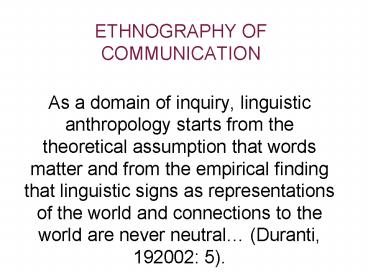ETHNOGRAPHY OF COMMUNICATION - PowerPoint PPT Presentation
1 / 17
Title:
ETHNOGRAPHY OF COMMUNICATION
Description:
ETHNOGRAPHY OF COMMUNICATION. As a domain of inquiry, linguistic anthropology ... prosodic features --syntax --choice of words --nonverbal cues. Terms of address. FN, ... – PowerPoint PPT presentation
Number of Views:270
Avg rating:3.0/5.0
Title: ETHNOGRAPHY OF COMMUNICATION
1
ETHNOGRAPHY OF COMMUNICATION
- As a domain of inquiry, linguistic anthropology
starts from the theoretical assumption that words
matter and from the empirical finding that
linguistic signs as representations of the world
and connections to the world are never neutral
(Duranti, 192002 5).
2
Sociolinguistics and Linguistic Anthropology
- Quantitative methods
- Urban environments
- Developed in the 1950s and 60s
- Connected to sociology
- Qualitative methods
- Small scale societies
- Subfield of Anthropology
- Developed by Frank Boas (early 1900s)
3
Influenced by Ethnography of Communication
- Dell Hymes (1960s and 1970s)
- Linguistics in the widest possible way folklore,
international linguistics, cognitive
anthropology, sociology, etc
4
Ethnography of communication The study of
communication in its widest cultural and social
context, including rules of language, norms of
appropriate language use in particular settings,
and evaluations given by members of a culture to
various speech styles
5
Concern with
- Segmentation of a speech communities class,
gender, race, age, and ethnicity - Alternative means utilised by speakers to obtain
goals - The roles of speakers as social actors
- The function of speaking as a social activity
6
Speech event and Context
- Would you be so kind as to pass me the salt?
- Gimme the salt!
7
Communicative rules
- Exist in all cultures
- Define acceptable behavior
- Give directives
- shape behaviour and help in evaluating others
- May change from context to context
- Cultural specific
8
The most important aspects of a communicative
interaction are
- Settings
- Participants
- topics
- Goals
- They are interconnected
- Two types of communicative interactions formal
and informal
9
Formal University Class
- Setting a fixed arranged local, A university
classroom - Participants are defined students and teachers
- Topics fixed math, history, anthropology, etc
- Goals to teach and learn, etc.
10
Setting
- Arena for action
- Define events
- Culturally defined formalities
11
Universal Aspects of Formality (Irvine, 1979)
- Increased structuring rules of etiquette
- Consistency of co-occurrence choices stylistic
choices - Emphasis on positional identities of
participants play of multiple roles or
identities - Emergence of a central situational focus
constrains on choice of topic
12
Participants
- Speakers, addressees, and audiences
- Choice of speakers
- --pronunciation
- --prosodic features
- --syntax
- --choice of words
- --nonverbal cues
13
Terms of address
- FN,
- Title Last name (TLN)
- Reciprocal FN and TLN
- Non-reciprocal FN-TLN and TLN-FN
- Pronouns T and V from the French Tu and Vous
- Honorifics markers that signal respect
14
Nahuatl degrees of respect
- I. intimacy and subordination prefixes between
intimates of similar age and status to signify
closeness - II. Neutrality and distance prefixes employ
among strangers - III Honour to address older woman and men
- IV Restricted to people who are in a compadrazgo
relationship
15
TOPICS and GOALS
- TOPICS
- Preference of co-participants
- Disapproval of violations of rules
- GOALS
- Individual and collective
- Expressed in a variety of forms
- Formal or informal language
16
SUMMARY
- Sociolinguistics and linguistic anthropology
- Dell Hymes Ethnography of Communication
- Language and context
- Alternative linguistic means to achieve goals
- Language functions
17
(No Transcript)



























![Download Book [PDF] Child Soldiers in Africa (The Ethnography of Political Violence) PowerPoint PPT Presentation](https://s3.amazonaws.com/images.powershow.com/9915707.th0.jpg?_=20230803068)
![[DOWNLOAD]⚡️PDF✔️ Cuban Color in Tourism and La Lucha: An Ethnography of Racial Meanings (Issues PowerPoint PPT Presentation](https://s3.amazonaws.com/images.powershow.com/10041546.th0.jpg?_=202405290511)
![⚡[PDF]✔ Quick Ethnography: A Guide to Rapid Multi-Method Research PowerPoint PPT Presentation](https://s3.amazonaws.com/images.powershow.com/10048470.th0.jpg?_=20240605111)
![[PDF]❤️DOWNLOAD⚡️ Accompaniment with Im/migrant Communities: Engaged Ethnography PowerPoint PPT Presentation](https://s3.amazonaws.com/images.powershow.com/10050498.th0.jpg?_=20240607126)
![[PDF]❤️DOWNLOAD⚡️ Accompaniment with Im/migrant Communities: Engaged Ethnography PowerPoint PPT Presentation](https://s3.amazonaws.com/images.powershow.com/10050559.th0.jpg?_=20240607119)